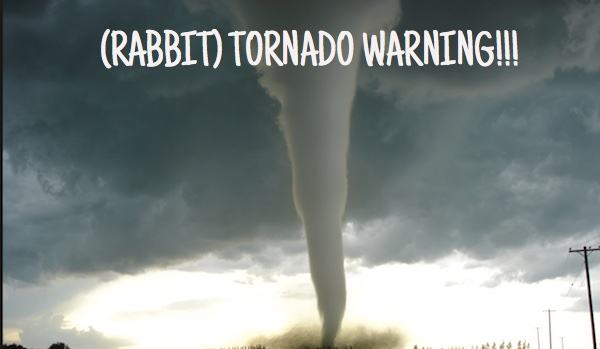You are doing what you can to support the bonding process. But when should you step in?
There are many behaviors that may look a little alarming but that don’t require intervention. CHASING, MOUNTING, etc were covered earlier and should be permitted as long as nobody is getting irritated.
BITING, CLOSE CIRCLING, GROWLING, LUNGING…tempers are flaring and damage can be done. You want to interfere here before a TORNADO. EARS go back and the ear folds turn under. TAILS ARE UP, HEADS ARE RAISED, and FRONT PAW STANCES ARE WIDENED.
How can you interfere safely, so you and the rabbits don’t get hurt?
Use the trusty broom you’ve got on hand, get it between the rabbits, and chase one of them away.
Both rabbits may be full of fight, or can be terrified, and may well still bite at this point. So use caution – your rabbit will not be thinking “this is my person, totally safe, no need to bite”. They may lash out at anyone. You may even choose to use gloves to remove one rabbit from the area.
Both rabbits will need to be checked very thoroughly for injury. Injuries can mean bites, skin tears, puncture wounds, abscesses, scratches, or pulled muscles. Get out your phone and call your exotics or rabbit-savvy vet if you suspect there have been any bites or punctures.
STOP THESE FORMS OF AGGRESSION QUICKLY, as rabbits have great memories and will hold a grudge. Give them a break from the bonding dates and maintain the swapping pens until everyone seems calm and relaxed again. Then start over, with the first sessions quite short. The rabbits need to establish trust now with a bad history behind them, rather than a blank slate. This is certainly possible, don’t give up. Even rabbits who have been injured can bond. But go gently and very slowly, and watch carefully. Let the injured rabbit heal completely physically and emotionally before any more attempts at bonding.
When you do try again, try a new neutral space. Bunnies remember the details of a trauma, and can carry that emotional baggage for a long time. Continue to swap spaces each day and wait for dust to settle, then carry on in a new big neutral space.
If you have had a bad bonding session and have lost your own nerve, get help with the process before attempting another session. The rabbit will feel your anxiety and it will feed bad behavior. We want to minimize the bad experiences, so the rabbits can get past the distrust…so there is absolutely no shame in asking for help from someone who has done this many times and has experience. There are so many signals to watch for, so many little signs. It takes time to learn bunny language, so if you end up with a difficult bonding situation, you can’t expect to notice everything and deal with it.
Next in the lineup: how to move your rabbits in together to share one space.
Many thanks to Edie Sayeg of the Georgia House Rabbit Society for contributing to this series!







